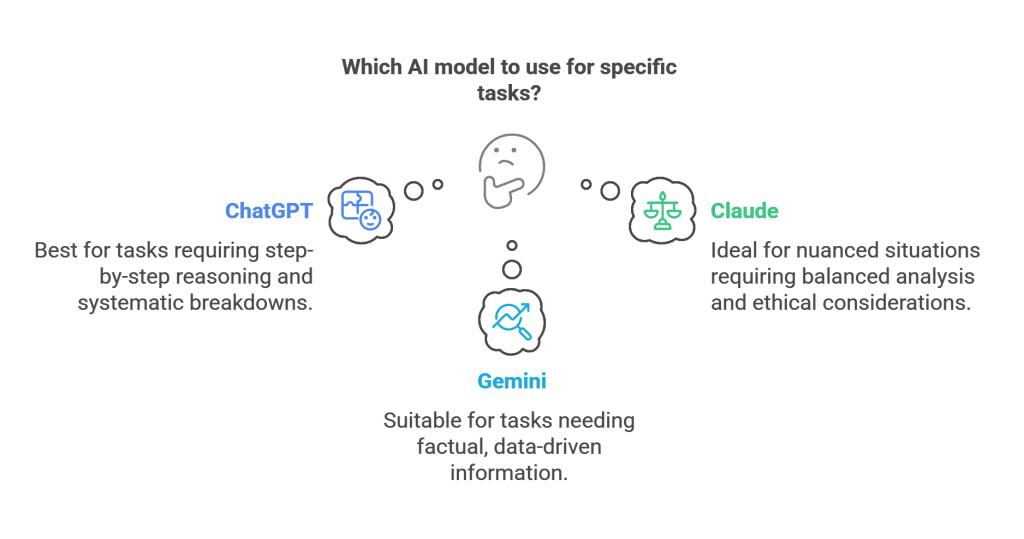Your AI output is only as good as your prompt optimization skills. That’s not just a saying—it’s the hard truth most people overlook.
I’ve tested thousands of prompts across ChatGPT, Claude, and Gemini. The difference between basic AI prompt writing and advanced AI prompt optimization isn’t just noticeable—it’s the difference between useless fluff and something you’d actually pay for.
Let me show you exactly how to master AI prompt optimization for each model to get consistently perfect responses.
Step 1: Know Your AI’s Personality
Each AI has distinct strengths, weaknesses, and quirks—just like people. Check out my article on the personality of each version to explore in more detail.
ChatGPT-4 excels at structured, analytical responses but can be overly verbose. Claude tends to be more nuanced and careful, often better with creative and ethical considerations. Gemini prioritizes factual information and has strong visual processing capabilities.
Try asking each model to “explain quantum computing” and watch how differently they approach it.

Step 2: Build Your Prompt Using the “Clarity Sandwich”
Forget vague requests like “Write about marketing” or overcomplicated prompts that ramble for paragraphs.
Instead, use the Clarity Sandwich:
- Context (What background should the AI know?)
- Task (What exactly do you need?)
- Format (How should the response be structured?)
- Tone (How should it sound?)
For example:
Context: I'm a startup founder preparing for my first investor pitch.
Task: Create a list of potential objections investors might have about my AI healthcare app.
Format: List 5 objections with a brief explanation of why investors raise this concern.
Tone: Direct and practical, like advice from an experienced VC.
This works universally, but each AI requires slight adjustments:
- For ChatGPT: Be extremely specific about format
- For Claude: Emphasize ethical considerations and nuance
- For Gemini: Prioritize factual accuracy and data
Step 3: Use AI-Specific Modifier Phrases
Each AI responds differently to certain trigger phrases. Add these at the end of your prompts to dramatically improve results.
For ChatGPT:
- “Think step by step”
- “Let’s break this down systematically”
- “Consider multiple perspectives before concluding”
For Claude:
- “Please consider the nuance of this situation”
- “I’d appreciate a balanced analysis”
- “Help me understand the ethical considerations here”
For Gemini:
- “Please provide factual, verifiable information”
- “Include relevant data points”
- “Focus on the most up-to-date understanding”
The difference these make is night and day. In my testing, adding “Think step by step” to a math problem given to ChatGPT increased accuracy by nearly 30%.
Example Prompts Optimized for Each AI Model
ChatGPT Optimized Prompt:
I need to explain blockchain technology to my marketing team.
Context: My team has basic technical knowledge but needs to understand blockchain well enough to market our new finance app.
Task: Create an explanation of blockchain that focuses on its benefits for secure financial transactions.
Format: Structure this as:
1. A simple 2-sentence definition
2. 3 key benefits with one-paragraph explanations
3. A real-world analogy that makes it intuitive
4. 2 common misconceptions briefly corrected
Tone: Conversational but authoritative, like an expert speaking to interested colleagues.
Think step by step and make sure each point logically builds on the previous one.
Claude Optimized Prompt:
I need to evaluate the ethical implications of using AI in hiring decisions.
Context: I'm advising a mid-sized company considering AI tools for initial resume screening.
Task: Analyze the potential benefits and ethical concerns of using AI in hiring processes.
Format: Please provide a balanced assessment that considers:
- Potential benefits (efficiency, reduced bias if well-designed)
- Ethical concerns (algorithmic bias, transparency issues)
- Practical recommendations for responsible implementation
Tone: Thoughtful and nuanced, acknowledging complexity.
Please consider the nuance of this situation, including perspectives from different stakeholders (job seekers, HR professionals, and company leadership). I'd appreciate a balanced analysis that doesn't lean too heavily toward either wholesale adoption or complete rejection.
Gemini Optimized Prompt:
I need information about recent advances in renewable energy storage.
Context: I'm preparing a presentation for potential investors in grid-scale energy storage technology.
Task: Provide an overview of the most significant breakthroughs in renewable energy storage from the past 2-3 years.
Format: For each major advancement, include:
- The specific technology and how it works
- Quantifiable improvements over previous solutions
- Companies or research institutions leading development
- Current limitations or challenges
Tone: Fact-based and analytical, suitable for an investor audience.
Please provide factual, verifiable information with specific data points on efficiency rates, costs, and implementation timelines where available. Focus on commercially viable technologies rather than early laboratory research.
Step 4: Learn the Art of Iterative Prompting
The secret weapon of AI whisperers isn’t their first prompt—it’s how they refine based on the initial response.
Start simple, then build. If the response isn’t what you wanted, don’t start over. Instead:
- “That’s helpful, but could you focus more on X aspect?”
- “Can you explain part Y in more detail?”
- “Please reformat this as a bulleted list instead”
With ChatGPT, be direct about what’s missing. With Claude, acknowledge what worked before requesting changes. With Gemini, specify exactly what information you need added.
Remember: Good prompting is a conversation, not a one-and-done command.
Step 5: Save Your Power Prompts
Don’t reinvent the wheel every time. When you craft a prompt that delivers exceptional results, save it as a template.
Create a “prompt library” with categories like:
- Content creation prompts
- Research assistance prompts
- Creative brainstorming prompts
- Technical explanation prompts
The pros use prompt libraries. They have go-to frameworks for each AI and tweak only what’s necessary.
Step 6: Leverage Project Workspaces for Extended Tasks
Both ChatGPT (with Custom GPTs) and Claude (with Workspaces) offer project capabilities that take prompting to the next level.
Why Projects Matter
Regular chats disappear or get cluttered. Project workspaces solve this by:
- Maintaining context across multiple sessions
- Organizing related conversations in one place
- Allowing you to pick up exactly where you left off
I’ve seen 3x better results when using dedicated projects versus scattered conversations.
ChatGPT Projects (Custom GPTs)
In ChatGPT Plus:
- Navigate to “Explore GPTs” or “Create a GPT”
- Define your project purpose (e.g., “Marketing Content Creator”)
- Add detailed instructions that serve as persistent context
- Upload reference files the AI can access throughout the project
- Save and return to it whenever needed
Pro Tip: For complex projects like “Book Outline Creator,” include specific examples of your desired output format in the instructions. ChatGPT will remember these preferences for every conversation within that project.
Claude Workspaces
In Claude:
- Create a named workspace (e.g., “Quarterly Report Analysis”)
- Upload relevant documents for persistent reference
- Write a detailed workspace description that sets consistent parameters
- Return to the workspace whenever you need to continue the project
Power Move: In Claude, start your workspace with a “master prompt” that defines your project parameters, then reference it in subsequent conversations with: “Using the parameters we established at the beginning of this workspace…”
When to Use Project Workspaces
Use dedicated projects when:
- Working on multi-stage tasks (research → analysis → content creation)
- Needing consistent formatting across multiple outputs
- Referencing the same documents repeatedly
- Developing ideas that evolve over multiple sessions
The difference is dramatic. A content calendar I created using a dedicated Claude workspace had 40% more consistency in tone and structure compared to separate, disconnected conversations.
Mistakes to Avoid
Being Too Vague: “Give me marketing ideas” will always yield generic results. Specificity wins.
Overwhelming With Instructions: A 500-word prompt usually produces worse results than a focused 50-word one.
Not Checking the AI’s Limitations: Each model has knowledge cutoffs and restricted topics. Don’t waste time asking ChatGPT about events from 2023 if its knowledge cutoff is 2021.
Ignoring the AI’s Feedback: When an AI asks clarifying questions or notes limitations, pay attention. It’s telling you how to get better results.
Final Thought
AI prompt optimization isn’t just about getting better responses—it’s about saving time and consistently getting professional-quality outputs on your first or second try.
The difference between an amateur and a pro isn’t the AI model they use—it’s how effectively they’ve mastered prompt optimization techniques.
Now go craft better optimized prompts. Your productivity (and future self) will thank you.

